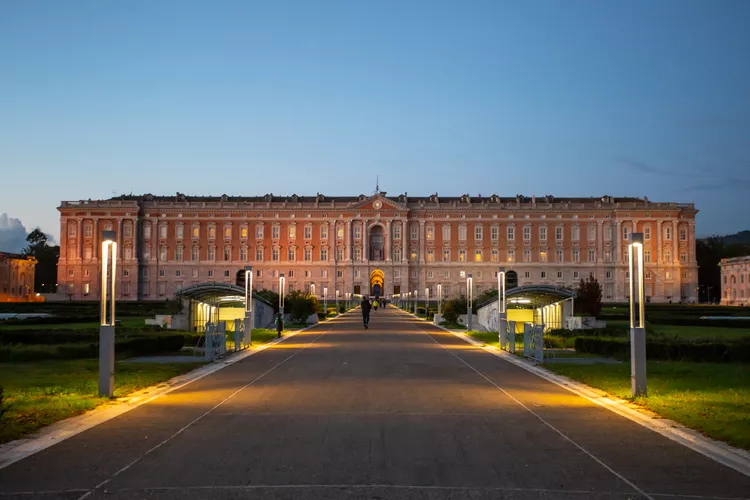Summary of World Heritage Sites in Southern Italy
- Matera – Sassi and Rupestrian Churches
- Naples Historic Center
- Castel del Monte
- Alberobello Trulli
- Caserta Royal Palace
- Pompeii and Herculaneum Archaeological Sites
- Amalfi Coast
- Paestum and Velia Archaeological Sites
- Sanctuary of the Archangel Michael in Puglia
- Sicily and Sardinia UNESCO World Heritage Sites
World Heritage Sites from Naples to the Heel of the Boot
Italy is home to 51 UNESCO World Heritage sites, with 9 located in the picturesque southern region. The World Heritage sites span a captivating array of city centers, palaces, caves, trulli, and archaeological locations. Listed by their UNESCO inscription dates, they begin with the remarkable Sassi of Matera, inscribed in 1993.
Matera – Sassi and Rupestrian Churches

Matera, an extraordinary town in the Basilicata region, is renowned for its unique sassi—ancient troglodyte settlements. The cave houses, carved from tufa, have been inhabited since Paleolithic times until the 1950s. Today, these historic dwellings have been revitalized, allowing visitors the opportunity to even stay in Sassi hotels. Additionally, the town showcases captivating Rupestrian churches nestled within the ravine.
Naples Historic Center

The historic center of Naples is a treasure trove of narrow streets, stunning churches, and impressive monuments. Castel dell’Ovo, the city’s oldest castle, stands majestically on the promontory. In the Spaccanapoli district, visitors can wander through a labyrinth of narrow pedestrian streets filled with charming shops and artisan workshops, particularly along Via San Gregorio Armeno, known for its exquisite nativity scenes.
Castel del Monte

Castel del Monte is a remarkable 13th-century castle, constructed by Emperor Frederick II as a military fortress. Its unique octagonal shape features a blend of classical, Islamic, and Gothic architectural styles. Located near Bari in the Puglia region, it offers a fascinating glimpse into the medieval past.
Alberobello Trulli

Trulli are distinct architectural structures featuring conical roofs, predominantly found in the Itria Valley of Puglia. The town of Alberobello boasts over 1500 trulli, many of which serve as residences, while others have been transformed into restaurants, shops, or holiday accommodations, enhancing the town’s charm and allure.
Caserta Royal Palace

The UNESCO World Heritage site encompasses the majestic 18th-century Caserta Royal Palace, along with its surrounding park, the Aqueduct of Vanvitelli, and the San Leucio Complex. This lavish Bourbon palace is modeled after Versailles, located northeast of Naples in the Campania region.
Pompeii and Herculaneum Archaeological Sites
Pompeii stands as one of Italy’s most renowned archaeological sites. Both Pompeii and Herculaneum were tragically engulfed by the eruption of Mount Vesuvius in 79AD, with much of their grandeur preserved beneath the volcanic ash. Visitors can easily embark on day trips from Naples to explore these remarkable sites, which also include the wall paintings of the Villa Oplontis located at Torre Annunziata.
Amalfi Coast

The Amalfi Coast is a stunning region characterized by its rugged coastline and breathtaking scenery. Enchanting medieval villages dot the coastline, showcasing significant architectural and artistic works. Historically, the town of Amalfi was a vital maritime republic during the Middle Ages.
Paestum and Velia Archaeological Sites and Cilento and Valle di Diano Park

The Cilento region, located south of Naples, has significant historical importance dating back to prehistoric times. The Greek temples at Paestum are remarkably well-preserved, and Velia is equally notable for its classical significance. Furthermore, the National Park of Cilento and Valle di Diano, which is Italy’s second-largest national park, stretches from the coastline to the Apennines, embodying the rich biodiversity of the area. Additionally, the Certosa of Padula stands as an important charter house within this captivating region.
Sanctuary of the Archangel Michael in Puglia

Located on Puglia’s Gargano Promontory, the Sanctuary of the Archangel Michael is part of the UNESCO World Heritage inscription known as Longobards in Italy – Places of the Power, which includes seven significant Longobard churches and monuments from the 6th to 8th centuries. Notably, the Church of Santa Sofia in Benevento is also recognized within this inscription, highlighting the region’s unique heritage.
Sicily and Sardinia UNESCO World Heritage Sites
The islands of Sicily and Sardinia, often linked to southern Italy, boast six UNESCO World Heritage sites encompassing a variety of prehistoric sites, Greek and Roman remains, as well as Baroque towns. These heritage sites reflect the rich history and cultural significance of the islands.
Overall, southern Italy’s UNESCO World Heritage sites offer a remarkable journey through time, showcasing its diverse and rich architectural heritage, stunning landscapes, and historical significance.





